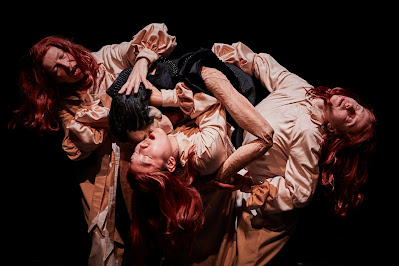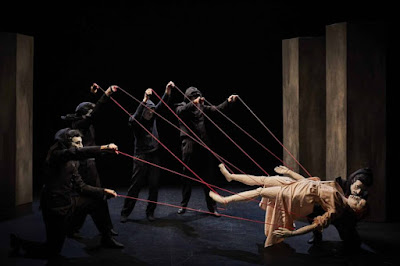Fresh blood for classic novel
©Christophe Raynaud de Lage
As the title suggests, the protagonist of the show is the beautiful and sexy Lucy, one of the minor characters in the novel, Count Dracula's first victim in England. Lucy is the friend of Jonathan Harker's fiancée Mina and is a sleepwalker.
The show begins directly in Lucy's dream, which she has one night while sleepwalking. Lucy sees herself in her dream; there are two Lucy's on the stage, one at the front on the right, the other at the back on the left, behind two black veils that cross the stage lengthwise, mirroring the first one upside down. The one at the front is an actor, the one at the back a human-sized puppet. As the narrative progresses, Lucy, Dracula and other characters are sometimes played by actors and sometimes by human-sized puppets. The illusion that director and puppet artist Yngvild Aspeli, who is also the founder of the company, has successfully created by using both human-sized puppets and actors on stage at the same time, by mixing the human body with puppet elements in some scenes, and by creating a mise-en-scene in which the actors and puppets are almost intertwined, makes it almost impossible to tell which figure on stage is real and which is a puppet throughout the show, blurring the line between reality and fantasy. This dual situation that Aspeli creates on stage is, in my opinion, an ingenious invention in terms of referring to the "in-between" characteristics of both the dream world and the vampirisation process, and it is effectively realised. It also provides the narrative with exactly the eeriness it needs.
©Christophe Raynaud de Lage
Lucy is portrayed in the novel as a character who is very much like her friend Mina in many ways, but who differs from Mina in one very important way: Lucy is a sexual object because of her beauty, so much so that she has three suitors. Lucy also shows an ease with her attractiveness that Mina never feels; in a letter to Mina she complains: "Why don't they let a girl marry three men, or as many as she likes, and save her all this trouble?
Lucy is bitten several times by Dracula, and as we all know, the vampire bite is an allegory for sexual intercourse. After the biting scenes, Lucy, who cannot be restrained by the doctor and her relatives, grows many of her own heads out of her body. Lucy has multiplied; it is as if she has been possessed by the desires revealed in her letter.
In the show, both the struggle of the doctor and his relatives, who try to save Lucy with a transfusion, and Lucy's struggle within herself are presented with a very impressive visuality. In the scenes where Dracula bites Lucy, the blood is depicted with a red tulle-like fabric, and in the two blood transfusion scenes, the veins are depicted with red thread, giving the show a seductive beauty.
©Christophe Raynaud de Lage
©Christophe Raynaud de Lage
In this show, Yngvild Aspeli not only uses the technique of life-size puppets, but also the technique of black theatre, in which the use of light is crucial. In fact, this technique is one of the main tools that create the uncanny atmosphere of the show. Thanks to this technique, Dracula, the dog, the wolf and the bats, which are the horror figures of the story and are usually represented by puppets, suddenly appear out of the darkness or turn into each other. This heightens the disturbing nature of the narrative.
Aspeli describes how she sees his art as follows: “The use of life-sized puppets is at the center of my work, but the play of the actor, the presence of the music, the use of light and video, are all equal elements in communicating the story. I´m interested in the expanded language that is formed in the meeting point of these different expressions, and how it creates a multisensorial narration. A story can be told by words, but it can also be understood through a visual and physical perception. The choice of materials and colors can communicate a mood, sound can make you feel an underlying atmosphere and the quality of a gesture can express an emotion. Puppetry is a form that constantly is re-inventing itself. It goes beyond “genre”, and fearlessly crosses the borders of other artistic expressions. Puppetry is not only a form, it is a way of seeing the world, a language, a state of mind.” From Aspeli's words we can understand that the creative team she works with on her shows also does a great job and she usually works with the same team.
Composer Ane Marthe Sørlien Holen's music for the show, especially the song "Children of the night", which supports the eerie atmosphere of the show, and set designer Elisabeth Holager Lund's black, simple and minimal set design, consisting of moving, long and dark grey wall pieces, which is especially perfect for Lucy's nightmarish dream and her increasingly narrowed mood, are to be commended. The video work by visual artist David Lejard-Ruffet is functional and remarkable in its contribution to the continuity of scene transitions.
A team of five performers, namely Pascale Blaison, Dominique Cattani, Yejin Choi, Sebastian Moya, Marina Simonova and Kyra Vandenende, who are part actor, part puppeteer and part both at the same time, successfully realise the magical world of the creative team on stage.
©Mathias Leander Olsen
©Vincent Arbelet
Yngvild Aspeli studied at the Ecole Jacques Lecoq in Paris (2003-2005) and at the Ecole Nationale Supérieure des Arts de la Marionnette in Charleville-Mézières (2005-2008). In 2011, she founded the Plexus Polaire, a French-Norwegian company, and has created five shows up to Lucy's Dream, a co-production with Puppentheater Halle from Germany, which premiered in 2021. I hope one day to see Moby Dick, which is still in the company's repertoire...
[The Turkish version of this article was published on Tiyatro Tiyatro Dergisi.]









Comments
Post a Comment